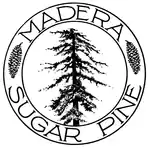 | |
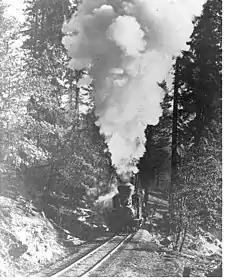 Hauling logs near Sugar Pine in 1915 | |
| Overview | |
|---|---|
| Locale | Sierra National Forest |
| Dates of operation | 1874–1931 |
| Successor | Yosemite Mountain Sugar Pine Railroad (1961) |
| Technical | |
| Track gauge | 3 ft (914 mm) |
| Length | 32 mi (51 km) |
The Madera Sugar Pine Company was a lumber company that operated in the Sierra Nevada region of California during the late 19th and early 20th centuries. It was known for its use of innovative technologies, such as the first log flume and logging railroad in the southern Sierra, and the adoption of the Steam Donkey engine in commercial logging.[1]: 10 [2] The company had a significant impact on the region, leading to the founding of several towns, including Madera, Fish Camp, and Sugar Pine, as well as the growth of Fresno Flats and the formation of Madera County. In addition, the company contributed to the agriculture in California in California through its production of wooden shipping boxes and was involved in a U.S. Supreme Court case related to employer obligations.
At its peak, The Madera Sugar Pine Company employed over 600 men in its logging operations and another 1,000 men in its lumbering plant, and produced 50 million board feet of lumber annually.[3] Most of the company's production was exported outside of California, and it even supplied two carloads of "the best Sugar Pine in the world" for Theodore Roosevelt's reconstruction of the White House.[4]: 35–37 [5] In total, the company logged over 6,200 acres (25 km2) acres and produced over 1.3 billion board feet of lumber before closing permanently in 1933 due to declining lumber supply and demand caused by The Great Depression. Despite the economic challenges of the time, The Madera Sugar Pine Company had shown a profit in every year of its operation.[6]: 146
In 1961, service resumed as the Yosemite Mountain Sugar Pine Railroad, a heritage railway. The railroad is built on a two-mile (3 km) section of the original railroad grade used between 1908 and 1924.[7][8]
Predecessors
The California Lumber Company (1874–1878)
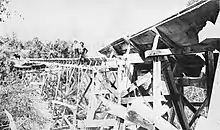
In February 1874, the California Lumber Company was established with the goal of transporting lumber from the Sierra Nevada to the recently completed railroad in the San Joaquin Valley.[9] The ambitious endeavor required the construction of lumber camps and mills, as well as a log flume to transport the lumber down from high elevations in the Sierra.[10]: 11
A 54-mile (87 km) log flume - the longest of its kind - was built to transport rough cut lumber from the mountains to the valley floor in Madera, where it could be finished and sold to the global market through the Southern Pacific Railroad. The route was surveyed in 1873 and construction began in 1874. The project required many high trestles to span the mountains and rolling foothills. The flume was ready for the 1877 season, with an estimated construction cost of $250,000.[1]: 16
_(14592230320).jpg.webp)
However, the California Lumber Company faced challenges with the creeping of lumber over the sides of the flume, resulting in both a loss for the operation and potential damage to the flume itself. William Thurman, one of the founders of the company, created a novel technique of clamping bundles of lumber together to prevent them from going over the edge during transport.[2] His flume clamp was patented in 1877.[11]
Despite these innovations, the company was underfinanced and was forced to cease operations after only three seasons, due to the drought of 1877.[11][12]
The Madera Flume and Trading Company (1878–1899)
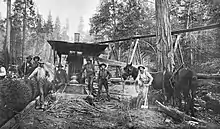
In 1878, the California Lumber Company underwent a major overhaul and was rebranded as the Madera Flume and Trading Company.[13] The new firm expanded logging operations by constructing a four-mile narrow gauge railway that connected the Soquel Mill to a flume, allowing for the transportation of more timber from further outlying areas.[1]: 20
In the late 1880s, the Madera Flume and Lumber Company made history by being the first to replace oxen teams with steam donkeys in a commercial logging operation.[2] The steam donkey, a small steam engine, allowed loggers to cut and transport more trees and work in any weather condition, thus increasing seasonal lumber production.[10]: 103, 127
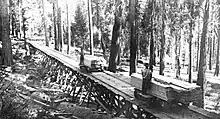
In 1881, the Soquel Mill was built and connected to a lengthened log flume upstream from the original California Mill. In 1882, a second California Mill was established near Nelder Grove. However, this mill lacked a nearby water source, so lumber was transported by a forest tramway to connect to the flume. By this time, the company was able to transport 100,000 board feet of finished lumber to Madera daily.[1]: 20–23
In 1889, the company introduced Betsy, an early Shay locomotive. She was the first of her kind to operate in the southern Sierra Nevada and represented a significant advancement in logging techniques and efficiency.[2] The Visalia Weekly Delta reported on the innovation.[1]: 26
Logging on the Madera Flume and Trading Company has been greatly facilitated this season by a new narrow-gauge (3-foot) railroad. Cars especially made for this purpose have done away with many [ox] teams in bringing lumber from the camps to the mill. Expenses at Madera and in the woods now exceed $15,000 per month – truly an enterprise of which any area might feel justly proud.
Betsy had a unique design, with a small cab that required the engineer to also serve as the fireman. Despite this quirk, Betsy became one of the longest-serving Shay locomotives in the Sierra and remained in service through the 1930s..[1]: 26, 44–45


Logging the Giant Sequoia
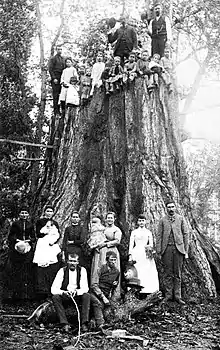
In the late 1800s, loggers in Nelder Grove cut down many giant sequoias. However, the wood from these trees had limited commercial potential due to its tendency to break apart when felled and its inferior suitability for construction compared to old-growth sugar pine and ponderosa. Despite this, more than 100 of the largest sequoias in the grove survived clearcutting by 1897.[14]
By the late 1890s, the Madera Flume and Trading Company began to decline as access to available timber tracts dwindled and demand for lumber exports weakened during a long economic depression.[15] The California Lumber Company mills were permanently shut down and the company filed for bankruptcy in 1878.[16] Only the Madera lumber yard continued to operate on a limited basis, sustained by contract loggers feeding cut logs to the flume.[1]: 27
The Madera Sugar Pine Company (1899–1931)
By the turn of the century, the old-growth white pine of the upper Midwest had become depleted. Sugar pine, with its large size and straight grain, became a highly valued substitute for white pine. This led many established lumber interests to push westward into the Sierra Nevada.[17]
In 1889, Arthur Hill, a Michigan-born timber magnate, and his associates purchased the assets of the Madera Flume and Trading Company and expanded its operations. Its existing logging railroad was extended to newly secured timber tracts, and the flume to Madera was reconstructed. The scale of the operation was expanded to rival the Fresno Flume and Irrigation Company and Sanger Lumber Company, which had sprung up as competitors.[1]: 12
The sugar pine tree became the central symbol for the reincorporated company. It featured in the company's name and logo and became the namesake for the newly constructed company town and state-of-the-art mill.[18][1]: 45
Log flume reconstruction
A new earth dam on the Lewis Fork of the Fresno River served two purposes. It formed a log pond to serve the new Sugar Pine mill and created a water source for a new flume head. The completely rebuilt flume followed the original fifty-four miles (87 km) route through Fresno Flats, dropping a total of 4,500 feet (1,400 m) elevation on the journey to Madera. To maintain the proper grade, over 200 trestles were built, some of them 65 feet (20 m) high.[4]: 45–46 The flume cost $275,000 to construct, an average of $5000 per mile. It used approximately 5,700,000 feet of redwood lumber and 2100 kegs of nails.[19]
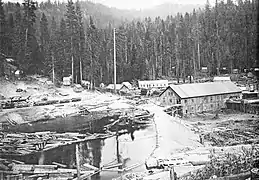 The log pond at Sugar Pine Mill.
The log pond at Sugar Pine Mill. Flume trestle at the China Store grade.
Flume trestle at the China Store grade.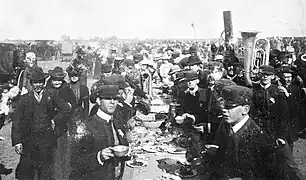 Residents of Madera celebrate the completion of the "world's longest lumber flume" on October 27, 1900.
Residents of Madera celebrate the completion of the "world's longest lumber flume" on October 27, 1900.
1922 Sugar Pine fire
A catastrophic fire swept through the town on September 9, 1922.[20] The sawmill, lumber yard, and 75 acres (0.30 km2) acres of surrounding forest were destroyed.[1]: 71–74
Madera Sugar Pine immediately announced plans to rebuild and expand. Equipment was ordered, manufactured and shipped from the eastern US by rail, including a modern two-band sawmill. Crews worked throughout the winter to transport and assemble over 500,000 pounds (230,000 kg) of equipment, hauling it over 60 miles (97 km) miles of dirt road from Madera to the mill site.[21][1]: 72 Operations resumed the following April with an expanded capacity of 350,000 board feet a day.[22]
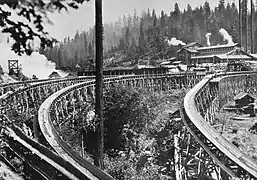 The flume complex at the second Sugar Pine Mill.
The flume complex at the second Sugar Pine Mill.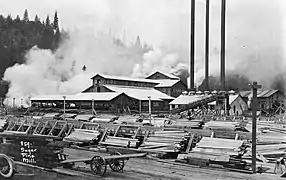 The expanded flume loading yards.
The expanded flume loading yards.
Life and Work

The sawmill community at Sugar Pine was diverse, with workers from many different nationalities. Social status within the community was based on a person's position with the company, and housing was allocated accordingly. Management lived in the upper canyon, sawmill workers in the lower canyon, and shop workers on the side of the hill. Loggers would live in seasonal camps in the woods, where they would sleep four to a shack and eat in a common cookhouse. Chinese laborers, whose jobs were limited to the flume, drying yard and sawmill, lived in a separate Chinatown area south of the mill.
Chinese Labor
Chinese workers, many of whom had arrived during the California Gold Rush, played a significant role in completing the Madera Flume and filling many of the jobs in the Sugar Pine lumber yards.[23][1]: 14 However, these Chinese workers faced significant discrimination and segregation in the workplace and in their daily lives. They were relegated to low-paying jobs as common laborers, were hired and paid through a middleman, and lived in a separate Chinatown apart from the rest of the community.[1]: 71, 82 Anti-Chinese sentiment and lack of legal protection also hindered the Chinese workers' experience, particularly in the wake of the Chinese Exclusion Act.[1]: 81
In 1922, Madera Sugar Pine decided to replace these Chinese laborers with Mexican laborers who had become readily available following the Immigration Act of 1917. In a move that would send a clear signal that Chinese workers were no longer welcome, the company set fire to Chinatown at the end of the logging season, waiting until the first snowfall to ensure that no other structures would be damaged in the blaze. This incident highlights the discrimination and injustice faced by Chinese workers in the logging industry during the early 20th century.[24]
Sex Work
Prostitution flourished in the Sierra during the logging days. The San Francisco fire of 1906 left many sex workers without work, so they went to the logging camps. Law enforcement left them be, and they traded at the company store and received medical care at the company hospital. They accepted all customers, showing no discrimination beyond the ability to pay.[1]: 76–79
The first brothel for the loggers of Madera Sugar Pine Company was called Kamook, located four miles from Sugar Pine. Tipperary was the most popular. Named after the popular song, Tipperary featured a main parlor house and four individual cabins. Accommodations at Kamook were scarce, so the sex workers set up a tent community called "Happy Camp" two miles away in Fish Camp, California. Business boomed, and the sex workers soon hired carpenters to construct a permanent brothel.
Prostitution houses stood for just over twenty years, Tipperary being the first to fall when the logs near Big Creek were depleted and the logging moved on. Happy Camp and Kamook persisted until the 1920s.[1]: 76–79
Supreme Court case
In the 1923 case Madera Sugar Pine Co. v. Industrial Accident Commission of California, the United States Supreme Court upheld death benefits to the non-resident alien dependents of employees who died as a result of no-fault industrial accidents. The decision upheld the Workmen's Compensation Act of California, which was found to not be in violation of the U.S. Constitution. The ruling required that the Madera Sugar Pine Company compensate the partially dependent survivors of two Mexican laborers who had died on the job. This case established the legal principle that non-resident alien dependents are entitled to the same compensation as citizens under the state's worker's compensation laws.[25][26]
Liquidation
The mill at Sugar Pine ceased activity in November 1931 with wood piling up in the Madera lumber yard due to the Great Depression. With the economic situation showing no signs of improvement by 1933, the flume, lumber yard, planing mill and box factory were permanently closed.[1]: 90 [6]: 146 Every locomotive was sold or scrapped.[10]: 49
Locomotive Roster
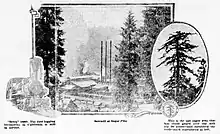
The Madera Sugar Pine Company (MSP) operated a fleet of seven locomotives. Of these engines, four were given official names, while the remaining three were assigned numerical designations. The first of these engines, Engine Number One, also known as Betsy, was a pioneering machine in the region. Despite its unconventional and early design, Betsy proved to be a reliable workhorse and remained in constant service until the MSP ceased operations in the early 1930s.
Betsy was a unique machine, with a small cab that required the engineer to also serve as the fireman. This quirk, however, did not detract from its performance, and Betsy became one of the longest-serving Shay locomotives in the Sierra. Its tendency to jump the track was a minor inconvenience.
On runs from the sawmill to the woods, Engine Number 2, 3, and 4 generally pulled 15 empty log cars, while the larger three truck Shay locomotives, Engine Number 5 and Engine Number 6, could each pull 22 empty log cars. The length of incoming trains depended on the use of railroad grades at the time. The Shay locomotives were never turned, instead, the front end always pointed up the hill, a testament to their versatility. To enhance visibility and safety, the company retrofitted its Shay locomotives with battery-powered lights. However, these lights proved only as bright as oil lamps when fully charged. In 1933, the sawmill closed, and the company chose to dismantle the railroad in 1934, marking the end of an era for the Madera Sugar Pine Company, and all the engines were sold and scrapped by 1937.
| Name | Builder | Type | Date | Shop number | Notes |
|---|---|---|---|---|---|
| Betsy[1]: 94 | Unknown | 0-4-0 Shay locomotive | Unknown | Unknown | The No. 1 engine, named Betsy, was the first steam locomotive to operate in the Southern Sierra. Despite its unconventional and early design, it remained in constant service until the MSP ceased operations in the early 1930s. Unlike the other MSP locomotives, it never received a painted-on title. |
| Arthur Hill[1]: 94 [27] | Lima Locomotive Works | Two truck Shay locomotive | December 27, 1902 | 755 | The Arthur Hill was built for Madera Sugar Pine Company with a fuel capacity of 1.5 cords of wood, water capacity of 1,560 gallons and an empty weight as built of 64,000 pounds. Delivered in Madera. It was scrapped in 1937. |
| E.M. Fowler[1]: 94 [28] | Lima Locomotive Works | Two truck Shay locomotive | February 27, 1904 | 862 | The E.M. Fowler was built for Madera Sugar Pine Company with a fuel capacity of 1.5 cords of wood, water capacity of 1,560 gallons and an empty weight as built of 70,950 pounds. Delivered in Madera. It was scrapped in 1937. |
| E.N. Briggs[1]: 94 [29] | Lima Locomotive Works | Two truck Shay locomotive | 1910 | 2280 | The E.N. Briggs was built for Madera Sugar Pine Company with an empty weight as built of 84,000 pounds. Delivered in Raymond. It was scrapped in 1937. |
| Madera Sugar Pine Company #5[1]: 94 [30] | Lima Locomotive Works | Three truck Shay locomotive | 1912 | 2617 | Built for Madera Sugar Pine Company with an empty weight of 120,000 pounds. Delivered in Raymond. Sold to Diamond & Caldor for parts in 1937 for $500. |
| Madera Sugar Pine Company #6[1]: 94 [31] | Lima Locomotive Works | Three truck Shay locomotive | 1927 | 3306 | Built for Madera Sugar Pine Company with an empty weight of 135,500 pounds. Delivered in Raymond. Sold to Feather River Lumber Company in 1935. Converted to oil burner. Sold to Hyman-Michaels Company in San Francisco, 1943. Sold to Michigan-California Lumber Company (3rd No. 6) in 1944. Scrapped in 1951. |
| Madera Sugar Pine Company #7[1]: 94 | Plymouth | Gas Mechanical, 4 wheel, 20 Ton | 1927 | Unknown | Sold to Grants Gravel Company in Friant, California and converted to standard gauge. |
- Locomotives of The Madera Sugar Pine Company
 Betsy and a short log train
Betsy and a short log train Arthur Hill at the Lima Locomotive Works.
Arthur Hill at the Lima Locomotive Works.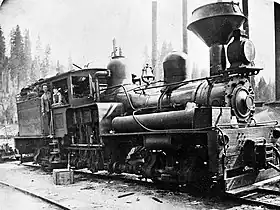 E.M. Fowler arrives at Sugar Pine.
E.M. Fowler arrives at Sugar Pine. No. 5 and a load of pine logs in 1918.
No. 5 and a load of pine logs in 1918.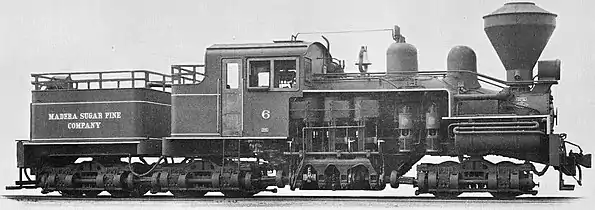 Builder's photo of No. 6.
Builder's photo of No. 6. No. 7 was the first gas-mechanical engine used by Madera Sugar Pine.
No. 7 was the first gas-mechanical engine used by Madera Sugar Pine.
Yosemite Mountain Sugar Pine Railroad
In 1961, service resumed as the Yosemite Mountain Sugar Pine Railroad, a heritage railway. The railroad is built on a two-mile (3 km) section of the original railroad grade used between 1908 and 1924.[7][8]
References
- 1 2 3 4 5 6 7 8 9 10 11 12 13 14 15 16 17 18 19 20 21 22 23 24 Johnston, Hank (1968). Thunder in the Mountains: The Life and Times of Madera Sugar Pine (Second Edition (Revised) ed.). Costa Mesa, Calif.: Stauffer Publishing. ISBN 0-87046-017-X. OCLC 239958.
- 1 2 3 4 Fresno Flats Historical Village and Park (Museum display). Oakhurst, CA: Madera County Historical Society. 2022.
- ↑ "Madera County Timber Resources". Madera Tribune. Madera, California. July 30, 1928. Retrieved August 7, 2022.
- 1 2 Barnes, Dwight H. (2001). Miners, Lumberjacks, and Cowboys: A History of Eastern Madera County. Oakhurst, Calif.: Sierra Historic Sites Association. ISBN 0-9707605-0-7. OCLC 50478275.
- ↑ "Lumber for the White House". Madera Mercury. Madera, California. October 18, 1902. Retrieved August 7, 2022.
- 1 2 Stenzel, Jane, ed. (2006). As We Were Told: An Oral and Written History (Third Edition (Revised) ed.). Coarsegold, California: Coarsegold Historical Society. ISBN 0-9626377-7-7.
- 1 2 Yosemite Mountain Sugar Pine Railroad Marker (Historic Marker). Fish Camp, CA: Grub Gulch Chapter 41-49 E Clampus Vitus. 1987.
- 1 2 "Sugar Pine Railroad on Full Schedule". Madera Tribune. September 24, 1968. Retrieved August 9, 2022.
- ↑ "The California Lumber Co". Merced County Sun. March 1874. Retrieved August 9, 2022.
The object of the company is to supply the San Joaquin Valley with a superior article of lumber at reduced prices. To accomplish this they design sawing the lumber in the great sugar-pine forests of Fresno Flats and floating the lumber down, by means of a flume, to a convenient point upon the railroad for shipping
- 1 2 3 Johnston, Hank (1997). The Whistles Blow No More. Stauffer Publishing. ISBN 0-87046-067-6.
- 1 2 "Construction of Madera Flume Realized Dream of W. H. Thurman". Madera Tribune. Madera, California. September 28, 1948. Retrieved July 23, 2022.
- ↑ "Sugar Pine Company Pioneer in Industry". Madera Tribune. Madera, California. May 3, 1927. Retrieved August 6, 2022.
- ↑ "Articles of Incorporation". San Jose Weekly Mercury. May 9, 1878. Retrieved August 9, 2022.
- ↑ Negley, Brenda L. (2016). Nelder Grove of Giant Sequoias: A Granddaughter's Stories. Otter Bay Books. pp. 89, 219. ISBN 978-0-578-18029-8.
- ↑ "Our History". The City of Madera. Retrieved July 29, 2022.
- ↑ "Fresno Items". Mariposa Gazette. February 23, 1878. Retrieved August 9, 2022.
The California Lumber Company has filed a petition in bankruptcy. A meeting of the creditors has been called for 18th of March, at the office of J.M. Glitchell, Register in bankruptcy, at San Francisco.
- ↑ "Sugar Pine Company Pioneer in Industry". Madera Tribune. Madera, California. May 3, 1927. Retrieved August 7, 2022.
- ↑ "Sugar Pine Company Adopts Seal Symbolic of Lumber Activities". Madera Tribune. January 14, 1928. Retrieved August 8, 2022.
- ↑ Bryant, Ralph Clement (1913). Logging: The Principles and General Methods of Operation in the United States (First ed.). New York: Wiley and Sons. p. 409.
- ↑ "Hunting and Sleep Forgotten as Fire Destroys Big Camp". Madera Mercury. September 12, 1922. Retrieved August 9, 2022.
- ↑ "Madera Sugar Pine Co. To Make Gigantic Effort to Start Operations March 1st". Madera Tribune. Madera, California. September 18, 1922. Retrieved August 6, 2022.
- ↑ "Sugar Pine Mill Resumes Operations: Friday the 13th is Lucky Day as Big Mill Cut for Year Starts at Sugar Pine". Madera Tribune. Madera, California. April 14, 1923. Retrieved August 6, 2022.
- ↑ "Song Fined $150, May Appeal Case: Sugar Pine Chinaman Found Guilty of Having an Opium Pipe in His Possession -- Plea of Attorney Gets Him Off Easy". Madera Mercury. January 4, 1918. Retrieved August 9, 2022.
- ↑ "Sugar Pine's Chinatown had its revenge". The Madera Tribune. August 8, 2017. Retrieved August 3, 2022.
- ↑ Madera Sugar Pine Co. v. Industrial Accident Commission of California, 262 U.S. 499 (1923).
- ↑ "Madera Sugar Pine Case is Settled by Supreme Court of U.S." Merced Sun-Star. June 5, 1923. Retrieved August 9, 2022.
- ↑ "Shop Number 755 – Built for: Madera Sugar Pine Co". The Full Shay Data Base. Retrieved July 23, 2022.
- ↑ "Shop Number 862 – Built for: Madera Sugar Pine Co". The Full Shay Data Base. Retrieved July 23, 2022.
- ↑ "Shop Number 2280 – Built for: Madera Sugar Pine Co". The Full Shay Data Base. Retrieved July 23, 2022.
- ↑ "Shop Number 2617 – Built for: Madera Sugar Pine Co". The Full Shay Data Base. Retrieved July 23, 2022.
- ↑ "Shop Number 3306 – Built for: Madera Sugar Pine Co". The Full Shay Data Base. Retrieved July 23, 2022.
Further reading
- Johnston, Hank (1997). The Whistles Blow No More. Stauffer Publishing. ISBN 0-87046-067-6.